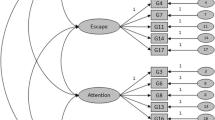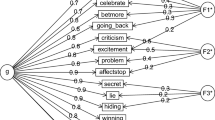Abstract
The gambling functional assessment-revised (GFA-R) was designed to assess whether the respondent’s gambling was maintained by positive reinforcement or escape. The present study attempted to validate the GFA-R’s psychometric properties using United Kingdom (UK) university students and to compare the results to those from a sample of American university students. Two hundred seventy four UK students completed the GFA-R, and 153 also completed the South Oaks gambling screen (SOGS). Two hundred one United States (US) university students completed both measures. A confirmatory factor analysis indicated that the original model of the GFA-R provided an excellent fit for the UK data and internal consistency was high. These outcomes were similar, if not superior, to those from the US sample. SOGS scores strongly correlated with GFA-R escape subscale scores in both samples, replicating previous results. These findings indicate that the GFA-R is a valid measure for use in the UK, which is potentially useful to both practitioners and researchers. They also suggest that the strong relationship between endorsing gambling as an escape and measures of disordered gambling may be ubiquitous.


Similar content being viewed by others
Notes
Probabilities represent results from two-tailed tests.
References
American Psychiatric Association. (2000). Diagnostic and statistical manual of mental disorders (4th ed., text revision). Washington, D.C.: Author.
Dixon, M. R., & Johnson, T. E. (2007). The gambling functional assessment (GFA): An assessment device for identification of the maintaining variables of pathological gambling. Analysis of Gambling Behavior, 1, 44–49.
Durand, V. M., & Crimmins, D. B. (1988). Identifying the variables maintaining self-injurious behavior. Journal of Autism and Developmental Disorders, 18, 99–117.
Ferris, J., & Wynne, H. (2001). The Canadian Problem Gambling Index: Final report. Ottawa, ON: Canadian Centre on Substance Abuse.
Ferris, J., Wynne, H., & Single, E. (1999). Measuring problem gambling in Canada: Draft final report. Ottawa, ON: Canadian Centre on Substance Abuse.
Fisher, S. (1999). A prevalence study of gambling and problem gambling in British adolescents. Addiction Research, 7, 509–538.
Forrest, D., & McHale, I. G. (2012). Gambling and problem gambling among young adolescents in Great Britain. Journal of Gambling Studies, 28, 607–622.
Gambino, B. (1997). The correction for bias in prevalence estimation with screening tests. Journal of Gambling Studies, 13, 343–351.
Hu, L., & Bentler, P. M. (1999). Cutoff criteria for fit indexes in covariance structure analysis: Conventional criteria versus new alternatives. Structural Equation Modeling, 6, 1–55.
Jawad, C., & Griffiths, S. (2010). Taming of the casino dragon. Community, Work & Family, 13, 329–347.
Kido, M., & Shimazaki, T. (2007). Reliability and validity of the modified Japanese version of the South Oaks Gambling Screen (SOGS). Japanese Journal of Psychology, 77, 547–552.
Lesieur, H. R., & Blume, S. B. (1987). The South Oaks Gambling Screen (SOGS): A new instrument for the identification of pathological gamblers. American Journal of Psychiatry, 144, 1184–1188.
Martner, S. G., Montes, K. S., & Weatherly, J. N. (2012). Using unsolvable anagrams to induce escape: Will it increase gambling behavior? Analysis of Gambling Behavior, 6, 46–53.
McLellan, A. T., Luborsky, L., Cacciola, J., Griffiths, J., McGahn, P., & O’Brien, C. P. (1988). Guide to the Addiction Severity Index: Background, administration, and field testing results (DHHS Publication No. ADM88–1419). Washington, DC: U.S. Government Printing Office.
Miller, J. C., Dixon, M. R., Parker, A., Kulland, A. M., & Weatherly, J. N. (2010). Concurrent validity of the gambling function assessment (GFA): Correlations with the South Oaks Gambling Screen (SOGS) and indicators of diagnostic efficiency. Analysis of Gambling Behavior, 4, 61–75.
Miller, J. C., Meier, E., Muehlenkamp, J., & Weatherly, J. N. (2009). Testing the validity of Dixon & Johnson’s (2007) gambling functional assessment. Behavior Modification, 33, 156–174.
Moodie, C. (2008). Student gambling, erroneous cognitions, and awareness of treatment in Scotland. Journal of Gambling Studies, 21, 30–55.
Muthén, L. K., & Muthén, B. O. (1998–2007). MPlus USER’S GUIDe (5th En.) Los Angeles, CA: Muthén & Muthén.
Neighbors, C., Lostutter, T. W., Cronce, J. M., & Larimer, M. E. (2002). Exploring college student gambling motivation. Journal of Gambling Studies, 18, 361–370.
Petry, N. M. (2005). Pathological gambling: Etiology, comorbidity, and treatment. Washington, D.C.: American Psychological Association.
Rigdon, E. E. (1996). CFI versus RMSEA: A comparison of two fit indexes for structural equation modeling. Structural Equation Modeling, 6, 369–379.
Stinchfield, R. (2002). Reliability, validity, and classification accuracy of the South Oaks Gambling Screen (SOGS). Addictive Behaviors, 27, 1–19.
Stinchfield, R. (2003). Reliability, validity, and classification accuracy of a measure of DSM-IV diagnostic criteria for pathological gambling. American Journal of Psychiatry, 160, 180–182.
Thompson, A., Walker, M., Milton, S., & Djukic, E. (2005). Explaining the high false positive rate of the South Oaks Gambling Screen. International Gambling Studies, 5, 45–56.
Wardle, H., Griffiths, M. D., Orford, J., Moody, A., & Volberg, R. (2012). Gambling in Britain: A time of change? Health implications from the British gambling prevalence survey 2010. International Journal of Mental Health and Addiction, 10, 273–277.
Weatherly, J. N., Mari, K., & Montes, K. S. (2012a). Gambling in a laboratory setting: A comparison of gambling for positive reinforcement versus as a potential escape. Analysis of Gambling Behavior, 6, 83–90.
Weatherly, J. N., & Miller, K. B. (2012). Exploring the factors related to endorsing gambling as an escape. International Gambling Studies. doi:10.1080/14459795.2012.703214.
Weatherly, J. N., Miller, J. C., Montes, K. S., & Rost, C. (2012b). Assessing the reliability of the gambling functional assessment—revised. Journal of Gambling Studies, 28, 217–223.
Weatherly, J. N., Miller, J. C., & Terrell, H. K. (2011). Testing the construct validity of the gambling functional assessment—revised (GFA-R). Behavior Modification, 35, 553–569.
Weatherly, J. N., Montes, K. S., & Christopher, D. M. (2010). Investigating the relationship between escape and gambling behavior. Analysis of Gambling Behavior, 4, 79–87.
Weiss, S. M., & Loubier, S. L. (2010). Gambling habits of athletes and nonathletes classified as disordered gamblers. The Journal of Psychology, 144, 507–521.
Williams, A. D., Grisham, J. R., Erskine, A., & Cassedy, E. (2012). Deficits in emotion regulation associated with pathological gambling. British Journal of Clinical Psychology, 51, 223–238.
Wood, R. T. A., & Griffiths, M. D. (2007). A qualitative investigation of problem gambling as an escape-based coping strategy. Psychology and Psychotherapy: Theory, Research and Practice, 80, 107–125.
Yu, C. Y. (2002). Evaluating cutoff criteria of model fit indices for latent variable models with binary and continuous outcomes. Dissertation for the degree Doctor of Philosophy in Education. University of California, Los Angeles.
Author information
Authors and Affiliations
Corresponding author
Appendix
Appendix
GFA-R
Please answer each question with the appropriate number from the following scale:
0 | 1 | 2 | 3 | 4 | 5 | 6 |
Never | Almost never | Seldom | Sometimes | Usually almost | Always | Always |
—1. | After I gamble, I like to go out and celebrate my winnings with others. | |||||
—2. | I gamble after fighting with my friends, spouse, or significant other. | |||||
—3. | I gamble when I feel stressed or anxious. | |||||
—4. | I like the sounds, the lights, and the excitement that often go along with gambling. | |||||
—5. | If I have a hard day at work or school, I am likely to gamble. | |||||
—6. | I gamble when my friends are gambling with me. | |||||
—7. | I find myself feeling a rush, and getting excited, when I gamble. | |||||
—8. | When I gamble, I choose which games to play based upon my best chance of winning. | |||||
—9. | I gamble to get a break from work or other difficult tasks. | |||||
—10. | I gamble when I am feeling depressed or sad. | |||||
—11. | I find that gambling is a good way to keep my mind off of problems I have in other parts of my life. | |||||
—12. | I gamble when I am in debt or need money. | |||||
—13. | I really enjoy the complementary perks that come along with gambling, like free points, drinks, comp coupons, etc. | |||||
—14. | I enjoy the social aspects of gambling such as being with my friends or being around other people who are having a good time and cheering me on. | |||||
—15. | I gamble when I have a work project or class assignment that is due in the near future. | |||||
—16. | I gamble primarily for the money that I can win. | |||||
Items 1, 4, 6, 7, 8, 13, 14, and 16 are should be summed to give a score for gambling maintained by positive reinforcement. Items 2, 3, 5, 9, 10, 11, 12, and 15 should be summed to give a score for gambling maintained by negative reinforcement.
Rights and permissions
About this article
Cite this article
Weatherly, J.N., Dymond, S., Samuels, L. et al. Validating the Gambling Functional Assessment—Revised in a United Kingdom Sample. J Gambl Stud 30, 335–347 (2014). https://doi.org/10.1007/s10899-012-9354-5
Published:
Issue Date:
DOI: https://doi.org/10.1007/s10899-012-9354-5




